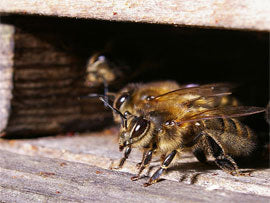Honeybees Focus on Flowers
Summer gardens are alive with insect activity but flower-bound honeybees focus on flowers so they are unlikely to sting. Blooming borders and heady herbs are summertime's garden lure to all types of critters. As a lifelong gardener, I'm drawn into the garden by rows of cutting flowers competing with their crayon-box of colors. And I'm not alone.
Season-long variety draws many types of bees like this bumblebee
Pollinator Flower Hour
The flowering plants of summer attract an array of garden visitors. Once you begin offering pollinator plants in your garden, you will notice a dramatic uptick in traffic.
Look carefully and you'll see an amazing variety of creatures enjoying the garden palette. Bees are a good example. Summer's lack of significant nectar sources from trees or shrubs in our area (NC USDA Zone 8a) sends them on a flower by flower journey sampling your garden buffet. And honeybees focus on their flower foraging.
Buckwheat attracts a wide range of pollinator species to watch in the garden
Garden Visitors Focus on Flowers
Honeybees are riding a positive media wave of public opinion right now. And for good reason - there are many benefits to buzzers in the garden, not the least of which is pollination. But many folks I talk to are nervous around bees, especially in the garden where many types of buzzing things gather in large numbers and seem rather intimidating.
Bees vs Yellow Jackets
Comparison of yellow jacket vs honeybee (photo by rescue.com)
But chances are you'll never bee stung in the garden. Ok, there are exceptions - the bee you didn't see before you picked a flower, the one you stepped on barefoot, etc. And this may be a real worry for the small fraction of the population who is anaphylactically allergic to stings. But for the other 99% of us, it's an unlikely concern. Note that I said bee stung. I take great exception to yellow jackets - they are not bees. They are of the ornery hornet family and are more aggressive than a pit bull defending their home territory, which is often in the ground/lawn. Yellow jackets should be eliminated from the home landscape when found as they pose a significant sting risk, especially to the very old or young.
Still I maintain you're highly unlikely to bee stung in the garden. Here are the three main reasons:
1. Foraging honeybees are on offense.
Bees are only equipped to sting once. Bees carry a serrated stinger that gets caught in human skin. Stinging us hooks their stinger and attached venom sac in our skin, disemboweling the bee as it flies off. So stinging is a last resort. Bees save their firepower for critical moments, particularly in defense. Bees fervently protect their homes & honey stores but have little other reason for aggression. They sting to protect in defense of their hive. When they are in the garden, they are on offense - seeking out flowers for pollen or nectar not defending the Alamo.
Honeybees are disemboweled by stinging human skin.
2. Stinging isn't a honeybee forager's job.
Foraging bees are the eldest, most experienced in the hive. Foraging is their final assignment in the age-appropriate chore splitting within the hive. The forager bees use their systems & skills to efficiently find the richest food sites to feed the colony.

Guard bees at hive entrance (photo by Big Island Bees)
So who does the stinging? Generally the guard bees. These teenage bees take post at hive entrances and regularly patrol the immediate area for potential insect or mammal invaders. They aren't out surveying the floral landscape. Foragers' venom & stinging apparati are fully developed - they can, and will, sting if necessary. But it would be under extreme situations of distress - the hive is being robbed, the bee's personal safety is in jeopardy, etc. The bottom line is that the grocery getters aren't the SimpliSafe of the hive.
3. Honeybees focus on flowers
My favorite meme category - the kids never think it's as funny as I do
I love 'You Only Had 1 Job" memes. They are my social media indulgence. Bees are excellent examples of only having one job. Foragers are charged with finding & hauling home food. And these honeybees are focused on their flowers. If there aren't bountiful food sources (like in the dead of summer here in NC) they kind of just hang out at the hive, resting up for the wake up call when a new source is found. They aren't prowling the garden looking for a sting victim. They are focused on their next Top Chef moment.
Flower Sharing With Bees
Working alongside bees is a joy - with no thought of stings
So as you work in the garden you can feel quite confident that everyone is on task. I have many times grabbed a flower to cut or a branch to prune and startled a foraging bee. You may surprise them but they aren't upset and are quick to move on to the next flower.
Often I find while cutting flowers or herbs from the garden, that the bees & I have selected the same flower to curate. No harm.
They finish their work on the bloom while it sits in the bucket of water and then move off elsewhere. Sometimes to rest on my arm or knee for a spell. It's tiring work for these flower-focused bees. And these foragers are aging bees.
Provided you aren't raising yellow jackets in the garden, you are generally quite safe among the bees. So plant those bee-loving flowers, herbs, and shrubs. You'll attract an amazing range of pollinators to watch.
Enjoy the side by side work of your fellow worker bees. You are both working focusing the same flower goal without a thought to stings.
